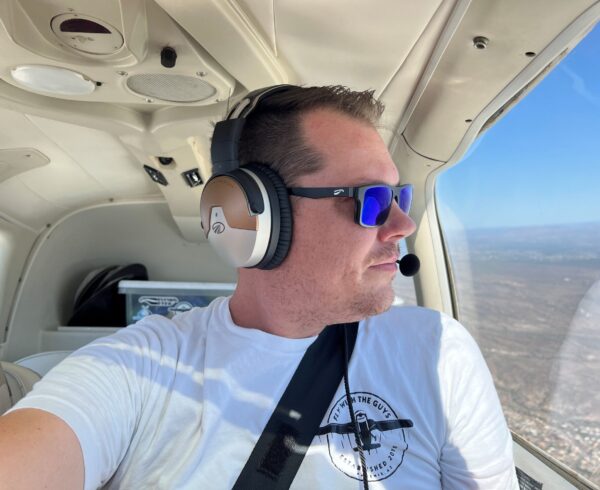Between travel bans, lockdowns, and the risk of crowded spaces, the COVID-19 pandemic has had a devastating effect on commercial airlines, with less than half of airline pilots still working. And general aviation was also temporarily grounded when lockdowns went into effect last March.
But here at Lightspeed, we quickly saw signs of recovery. Our President and founder, Allan Schrader, said “After the initial shock of the pandemic wore off, we were surprised at the uptick in headset sales. By summer, we noticed that more pilots were excited to be flying again and were celebrating their return to the air. Perhaps even some newer pilots may not have wanted to fly with a borrowed headset as a sanitary precaution for COVID. We were seeing, again, the resilience of our aviation market and the underlying passion of our pilots to ‘start flying again’.” So, we wondered, is GA recovering as fast as it looks to us?
The answer appears to be a resounding “Yes!” General aviation is now taking off in what AOPA President Mark Baker recently described as a mini boom. He happily notes, “there are actually more 172 Cessnas in the air than there are Boeing 737s. So general aviation is thriving.”
Relighting the Fires
Initially, the pandemic impacted nearly every aspect of general aviation. Non-essential flights were grounded, flight instruction stopped, and airshows were cancelled. The most obvious concern was how to prevent virus transmission in the enclosed space of an aircraft cabin. (For charter operators, this was also a liability issue.) In response, the NBAA published protocol cleaning guidelines, and HAI issued “Covid Clean” standards for rotorcraft operators. Disinfection procedures have become routine for aircraft owners and operators as well as airport facilities. Personal protective equipment has also become a routine part of flying, from hazmat suits for pilots flying medical missions to masked flight crew and passengers on routine flights (and maybe not borrowing headsets).
Flight certification and training have also adapted to the pandemic. Instructors and students are now masking up for training flights, but as Matt Thurber, editor-in-chief of Aviation International News, discussed in a fascinating FAA podcast, COVID lockdowns are driving major innovations in flight simulation, and more of flight training is becoming virtual. Thurber even describes doing a grueling IFR proficiency check virtually with a remote coach. The FAA has also offered relief during the pandemic, temporarily extending compliance deadlines for currency, flight review, medical certification, and knowledge testing requirements, and more recently expanding relief for Part 135 pilot training and qualification.
General aviation airports were impacted but are recovering quickly. Early in the pandemic, pilots were facing ATC-Zero situations in some small airports, but flights at some are now exceeding pre-pandemic levels. And AOPA and other industry organizations were able to get $100 million in federal COVID relief allocated to help fund the 5,000 public nationwide and the nearly 1 million people employed in running them – a sound investment, considering that general aviation accounts for more than one percent of U.S. GDP, according to the Aircraft Owners and Pilots Association.
Still Climbing
Despite the turbulence of 2020, general aviation is expected to keep growing, and the COVID pandemic actually triggered some positive changes. Charter flights are now expected to grow because private flying in small groups lowers COVID risks versus commercial airlines. And new passengers to charter flights are discovering that these flights offer great convenience for the same or only slightly higher cost. Tom Haines, editor-in-chief at AOPA, notes that around 50% of the customers coming to charter these days are new to general aviation. And AIN Online reports that furloughs and layoffs in commercial aviation have ended the shortage of business aviation pilots, so new corporate charter customers should find it easier to book flights.
In addition to the influx of pilots, experts are projecting a growing fleet of general aviation aircraft. AV Web reports that low interest rates are boosting aircraft sales. We can also look forward to technology improvements in flying, as NBAA noted, since sustainable aviation fuels, electric-powered VTOL vehicles, and hybrid fuel-electric vehicles progressed in 2020 despite the pandemic.
Clear Skies Ahead
All in all, the dark cloud of COVID-19 has had considerable silver linings for general aviation. Despite the initial shutdown, business aviation has bounced back faster and stronger than it did in the 2008 recession. Air cargo operations continued to thrive, fueled in part by the shift to online shopping. And, of course, GA pilots have been heroes of the pandemic, flying patients, delivering vaccines to remote areas, and bringing medical supplies to areas stricken by natural disasters.
Best of all, the industry is poised to welcome a new generation of pilots. Casey Ratliff, the owner of Texas Skies Flight School northwest of San Antonio, says he’s seen more young people considering aviation as a profession. He’s also seeing a new kind of student as the pandemic has made commercial flying less safe and convenient. “I’ve had a group of clientele. . . because of the outbreak, wanting to learn how to fly so that they can just get themselves from point A to point B.”
What better time or reason to take to the skies?















Hey that’s me!